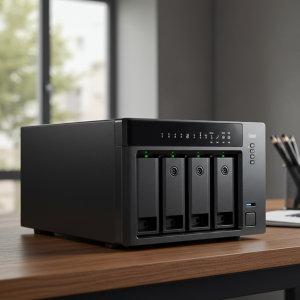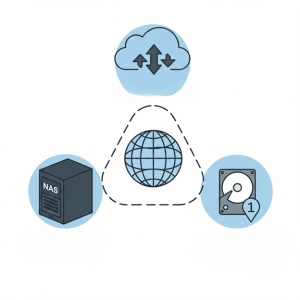Why Choose RAID? Business Implications for Business Owners
If You Have RAID:
✔ Minimizes downtime – Keeps operations running even if a drive fails.
✔ Protects critical data – Prevents the loss of customer records, financial data, or operational files.
If You Don’t Have RAID:
✖ Risk of data loss – A single drive failure can halt business operations.
✖ Costly recovery – Data restoration can take days and negatively impact revenue.
I Have RAID. What Does This Mean for My Business?
What Will NOT Happen to My Business:
✖ Sudden data loss – RAID prevents total failure from one dead drive.
✖ Extended downtime – Redundancy allows for quick recovery without needing full system rebuilds.
What Will NOT Happen If You Do Not Have RAID:
✖ Automatic failover – Without RAID, a failed drive results in immediate disruption.
✖ Seamless operations – Employees may lose access to critical files during important work.
Comprehensive Guide to Selecting the Optimal RAID Setup
Choosing the appropriate RAID (Redundant Array of Independent Disks) level is essential for balancing performance, capacity, and data protection when constructing a storage system (NAS with four 4TB drives). RAID makes sure that your data is safe even in the event of a drive failure, but there are different kinds of RAID configurations.

4-bay NAS (Network Attached Storage) device, commonly used in business environments for centralized data storage, file sharing, and RAID configurations.
RAID 5 is popular because it offers 75% storage efficiency, but it comes with risks. When a drive fails, rebuilding a 4TB drive can take hours or even days, increasing the chance of a second failure during recovery. For this reason, many experts recommend avoiding RAID 5 with drives larger than 2TB (DiskInternals Study on RAID 5 Risks).
RAID 6 is the safest option for mission-critical data because it can withstand two simultaneous drive failures. This is especially important when using large-capacity drives (4 TB+) where rebuild times are long. However, the trade-off is lower storage efficiency (only 50%) and slower write speeds.
RAID 10 (a combination of RAID 1 + RAID 0) is the best choice for most users because it delivers both speed and reliability. Unlike RAID 5/6, it doesn’t use parity calculations, so writes are much faster. The only downside is that it halves your total storage capacity—but the trade-off is worth it for many.
RAID 0,16TB (all 4 drives),None (lose 1 drive = total failure),Fastest but risky,Temporary/scratch data only.
RAID is not a backup! Always follow the 3-2-1 backup rule (3 copies, 2 media types, 1 offsite).

"RAID protects your hardware, but a 3-2-1 backup — 3 copies, 2 media types, 1 offsite - protects your data."
For most home and business users, RAID 10 is the best choice—it’s fast, reliable, and avoids RAID 5’s rebuilds risks. If you need more storage and can accept higher risk, RAID 5 works, but RAID 6 is safer for critical data. Avoid RAID 0 unless you’re working with non-essential files. By understanding these trade-offs, you can configure your 4x4 TB setup for optimal performance and security.
RAID Level Comparison
| RAID Level | Usable Capacity | Redundancy (Drive Failure Tolerance) | Performance | Best Use Case |
| RAID 5 | 12TB (3 drives) | 1 drive (can lose 1 drive) | Good read speed, slower writes due to parity | General-purpose NAS, file storage |
| RAID 6 | 8TB (2 drives) | 2 drives (can lose 2 drives) | Slower writes (double parity) | Critical data, high redundancy |
| RAID 10 | 8TB (2+2 mirrored & striped) | 1–2 drives (if failures are in different mirrors) | Fastest read/write speeds | Databases, virtualization, and high-speed workloads |
| RAID 0 | 16TB (all 4 drives) | None (lose 1 drive = total failure) | Fastest but risky | Temporary/scratch data only |
Additional Considerations
RAID is not a backup! Always follow the 3-2-1 backup rule (3 copies, 2 media types, 1 offsite). For NAS setups, consider Synology Hybrid RAID (SHR) or ZFS RAID-Z for improved flexibility (Synology RAID Guide). Monitor drive health using tools like CrystalDiskInfo (Windows) or smartctl (Linux).
For most home and business users, RAID 10 is the best choice—it’s fast, reliable, and avoids RAID 5’s rebuilds risks. If you need more storage and can accept higher risk, RAID 5 works, but RAID 6 is safer for critical data. Avoid RAID 0 unless you’re working with non-essential files. By understanding these trade-offs, you can configure your 4x4 TB setup for optimal performance and security.
"At Final Frontiers Systems Corp, we believe your business deserves IT that empowers, not complicates. With our proactive managed services, robust data protection, and dedicated local support, we handle the complexities of technology so you can focus on what you do best: innovating, growing, and achieving your vision. We're more than just an IT provider; we're your strategic partner in navigating the digital frontier."
RAID is insurance for your data; without it, you are risking your business continuity.
"Don't let IT challenges slow you down. Explore our comprehensive services or schedule a free IT assessment with Final Frontiers today to discover how we can elevate your business's digital capabilities."


